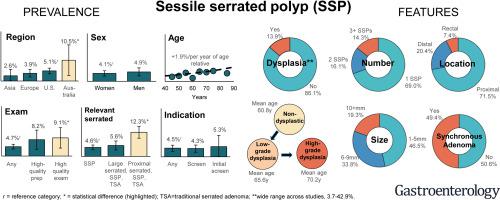Gastroenterology ( IF 25.7 ) Pub Date : 2020-03-18 , DOI: 10.1053/j.gastro.2020.03.025 Reinier G S Meester 1 , Marinika M A G C van Herk 2 , Iris Lansdorp-Vogelaar 2 , Uri Ladabaum 3

|
Background & Aims
Sessile serrated polyps (SSPs) could account for a substantial proportion of colorectal cancers. We aimed to increase clarity on SSP prevalence and clinical features.
Methods
We performed a systematic review of MEDLINE, Web of Science, Embase, and Cochrane databases for original studies published in English since 2000. We included studies of different populations (United States general or similar), interventions (colonoscopy, autopsy), comparisons (world regions, alternative polyp definitions, adenoma), outcomes (prevalence, clinical features), and study designs (cross-sectional). Random-effects regression was used for meta-analysis where possible.
Results
We identified 74 relevant colonoscopy studies. SSP prevalence varied by world region, from 2.6% in Asia (95% confidence interval [CI], 0–5.9) to 10.5% in Australia (95% CI, 2.8–18.2). Prevalence values did not differ significantly between the United States and Europe (P = .51); the pooled prevalence was 4.6% (95% CI, 3.4–5.8), and SSPs accounted for 9.4% of polyps with malignant potential (95% CI, 6.6–12.3). The mean prevalence was higher when assessed through high-performance examinations (9.1%; 95% CI, 4.0–14.2; P = .04) and with an alternative definition of clinically relevant serrated polyps (12.3%; 95% CI, 9.3–15.4; P < .001). Increases in prevalence with age were not statistically significant, and prevalence did not differ significantly by sex. Compared with adenomas, a higher proportion of SSPs were solitary (69.0%; 95% CI, 45.9–92.1; P = .08), with diameters of 10 mm or more (19.3%; 95% CI, 12.4–26.2; P = .13) and were proximal (71.5%; 95% CI, 63.5–79.5; P = .008). The mean ages for detection of SSP without dysplasia, with any or low-grade dysplasia, and with high-grade dysplasia were 60.8 years, 65.6 years, and 70.2 years, respectively. The range for proportions of SSPs with dysplasia was 3.7%–42.9% across studies, possibly reflecting different study populations.
Conclusions
In a systematic review, we found that SSPs are relatively uncommon compared with adenoma. More research is needed on appropriate diagnostic criteria, variations in detection, and long-term risk.
中文翻译:

无蒂锯齿状息肉的患病率和临床特征:系统评价。
背景与目标
无蒂锯齿状息肉(SSP)可能占结直肠癌的很大一部分。我们的目的是提高 SSP 患病率和临床特征的清晰度。
方法
我们对自 2000 年以来以英文发表的原始研究的 MEDLINE、Web of Science、Embase 和 Cochrane 数据库进行了系统回顾。我们纳入了不同人群的研究(美国普通人群或类似人群)、干预措施(结肠镜检查、尸检)、比较(世界各地)区域、替代息肉定义、腺瘤)、结果(患病率、临床特征)和研究设计(横断面)。尽可能使用随机效应回归进行荟萃分析。
结果
我们确定了 74 项相关结肠镜检查研究。 SSP 患病率因世界地区而异,从亚洲的 2.6%(95% 置信区间 [CI],0-5.9)到澳大利亚的 10.5%(95% CI,2.8-18.2)。美国和欧洲之间的患病率没有显着差异 ( P = .51);合并患病率为 4.6%(95% CI,3.4-5.8),SSP 占具有恶性潜能的息肉的 9.4%(95% CI,6.6-12.3)。通过高性能检查进行评估时,平均患病率较高(9.1%;95% CI,4.0–14.2; P = .04),并且采用临床相关锯齿状息肉的替代定义(12.3%;95% CI,9.3–15.4) ; P < .001)。患病率随年龄的增长并不具有统计学意义,而且患病率随性别的不同也没有显着差异。与腺瘤相比,单发性 SSP 的比例较高(69.0%;95% CI,45.9-92.1; P = .08),直径为 10 mm 或以上(19.3%;95% CI,12.4-26.2; P = 0.08)。 .13)并且是近端(71.5%;95% CI,63.5–79.5; P = .008)。检测无不典型增生、任何或低度不典型增生和高度不典型增生的 SSP 的平均年龄分别为 60.8 岁、65.6 岁和 70.2 岁。各项研究中,不典型增生的 SSP 比例范围为 3.7%–42.9%,可能反映了不同的研究人群。
结论
在系统评价中,我们发现与腺瘤相比,SSP 相对罕见。需要对适当的诊断标准、检测变化和长期风险进行更多研究。











































 京公网安备 11010802027423号
京公网安备 11010802027423号